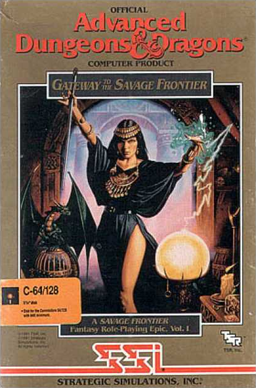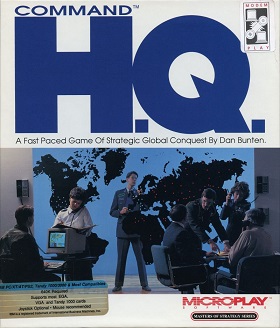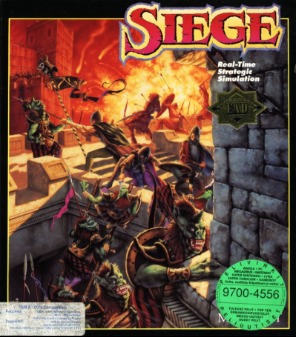
Pools of Darkness is a role-playing video game published by Strategic Simulations in 1991. It is the fourth entry in the Pool of Radiance series of Gold Box games, and the story is a continuation of the events of the third game, Secret of the Silver Blades. Like the previous games in the series, it is set in the Forgotten Realms, a campaign setting from Dungeons & Dragons. Players must stop an invasion from an evil god, eventually traveling to other dimensions to confront his lieutenants.

Darklands is a historical fantasy role-playing video game developed and published by MicroProse in 1992 for MS-DOS. The game is set in the Holy Roman Empire during the 15th century. While the geographic setting is historically accurate, the game features many supernatural elements.

Sword of the Samurai is an action and strategy video game developed and published by MicroProse in 1989 for the DOS platform. It features role-playing, strategy, and arcade elements set in feudal Japan. The player begins the game as a little-known vassal samurai; his ultimate goal is to replace Oda Nobunaga as the daimyō responsible for reunifying Sengoku Japan.

Rex Nebular and the Cosmic Gender Bender is a point-and-click graphic adventure game developed and published by MicroProse in November of 1992. The game is the first graphical adventure game developed by MicroProse, Return of the Phantom and Dragonsphere being the other ones. It was developed using the MicroProse Adventure Development system, and made use of 256-colour graphics. Tommo purchased the rights to this game and digitally publishes it through its Retroism brand in 2015.

Hillsfar is a role-playing video game for MS-DOS compatible operating systems, Amiga, Atari ST, and Commodore 64. It was developed by Westwood Associates and published by Strategic Simulations in 1989. It combines real-time action with randomly generated quests and includes elements of the Advanced Dungeons & Dragons fantasy role-playing game. A port to the Nintendo Entertainment System was released in 1993. Hillsfar received mixed reviews from critics.

J.R.R. Tolkien's The Lord of the Rings, Vol. I is a role-playing video game published by Interplay Productions. It is an adaptation of The Fellowship of the Ring by J. R. R. Tolkien, being the first volume in The Lord of the Rings. The game was released in 1990 for DOS, in 1991 for the Amiga and PC-98, and in 1992 for the FM Towns. It was followed by J.R.R. Tolkien's The Lord of the Rings, Vol. II: The Two Towers. It was originally designed for the Commodore 64, but the production team switched to the newer platforms. The game was designed by Troy A. Miles, Scott Bennie, Jennell Jaquays, and Bruce Schlickbernd. For the later versions, the cutscenes are taken from the 1978 Lord of the Rings film directed by Ralph Bakshi.

The Magic Candle: Volume 1 is a role-playing video game designed by Ali Atabek and developed and published by Mindcraft in 1989.

Gateway to the Savage Frontier (1991) is a Gold BoxDungeons & Dragons computer game developed by Beyond Software and published by SSI for the Commodore 64, PC and Amiga personal computers.

The Immortal is an isometric action-adventure game originally created by Will Harvey and released by Electronic Arts in 1990 for the Apple IIGS. It was soon ported to the Amiga, Atari ST, DOS, Nintendo Entertainment System, and Genesis. A wizard is attempting to find his mentor in a large and dangerous labyrinth. It has a high degree of graphic violence. In 2020, the NES port was re-released on the Nintendo Switch Online service, while the Genesis port was re-released on the Piko Collection Collection 1 cartridge for the Evercade.

Command HQ is a real-time strategy world domination game. It was released in 1990 by Microplay Software and was created by designer Danielle Bunten.

Eye of the Beholder II: The Legend of Darkmoon is a 1991 role-playing video game and the sequel to the first Eye of the Beholder. It used a modified version of the first game's engine, added outdoor areas and greatly increased the amount of interaction the player had with their environment, along with substantially more role-playing aspects to the game. A sequel, Eye of the Beholder III: Assault on Myth Drannor, was released in 1993.

BattleTech: The Crescent Hawks' Revenge is a real-time tactics game based in the FASA BattleTech universe. It is a direct sequel to BattleTech: The Crescent Hawk's Inception, though the gameplay is considerably different from that of the first title, which was primarily an adventure/role-playing game. Developed by Westwood Associates for Mediagenic, and produced by Scott Berfield, the game serves as a prototype for what later became Dune II, the first real-time strategy title on the PC.

Mines of Titan is a single-player role-playing video game, developed by Westwood Associates, and published by Infocom in 1989 for Apple II, Commodore 64, and MS-DOS.

Crusaders of Khazan is a computer adaptation of the tabletop role-playing game Tunnels and Trolls, developed and published by New World Computing in 1990 for DOS, FM Towns, PC-88 and PC-98. The game is available from Flying Buffalo and in Fiery Dragon's Tunnels and Trolls 30th Anniversary Edition. The game was an international production, designed and directed in the US but programmed in Japan.

Star Command is a video game released by Strategic Simulations in 1988.

Hyperspeed is a space combat role-playing video game developed by MicroProse Software in 1991 for DOS, and is a sequel to Lightspeed.

Prophecy of the Shadow is a 1992 fantasy role-playing video game developed by Strategic Simulations for MS-DOS. The game was released in both English and German versions.

Siege is a video game released by Mindcraft in 1992 for MS-DOS. An expansion pack, Dogs of War, was released. It added multiplayer, six new castles, and 16 new units to the game. A sequel, Ambush at Sorinor, was released in 1993.

Trevor Sorensen's Star Legions is a 1992 video game published by Mindcraft.

Warlords is a computer wargame released in 1990 for the Amiga and MS-DOS compatible operating systems, then in 1992 for Macintosh. It was designed by Steve Fawkner and developed by Strategic Studies Group. Warlords was followed by three sequels and several spinoffs. The game was based on designer Steve Fawkner's Dungeons & Dragons campaign.




















